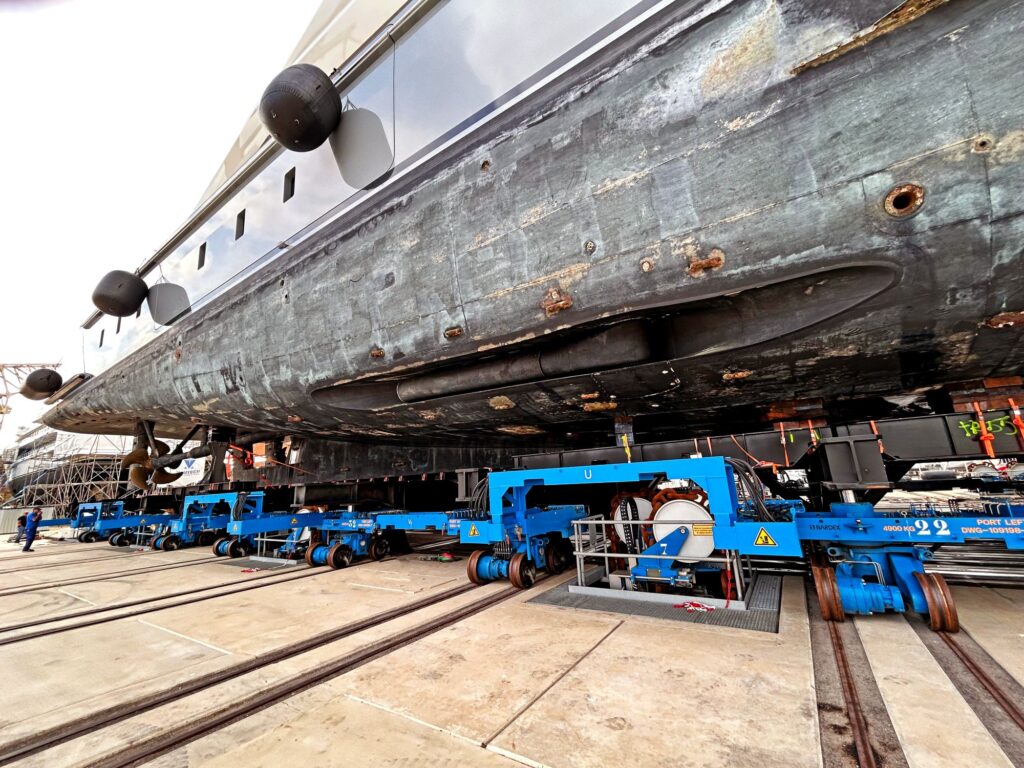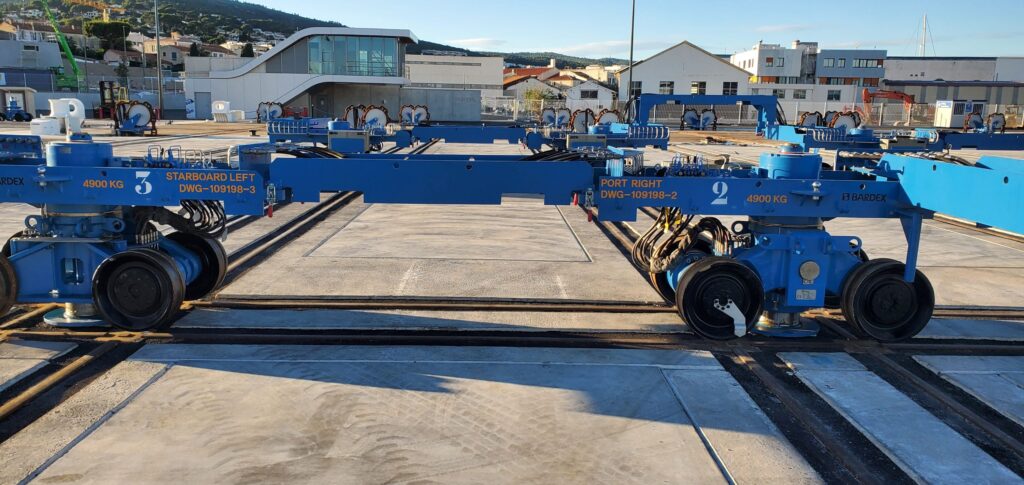Ship Support Systems
Bardex® designs and manufactures three types of ship support systems: trestles, cradles, and carriages.

Trestles
Trestles are individual structures consisting of one tapered plate girder. They are compatible with self-propelled modular transporter (SPMT) and rail-based bogie transfer system equipment. These are most commonly used for submarine docking. Trestles are very flexible and can support a variety of vessels and blocking arrangements.
Cradles
Cradles are a welded assembly consisting of two or more trestles with interconnecting steel to support additional keel and bilge blocking. Cradles are compatible with SPMT and rail-based bogie transfer systems. Cradles are flexible and accommodate a wide variety of vessels and blocking arrangements. Fewer cradle assemblies are required than individual trestles, and this design is more efficient in the use of steel material.
Carriages
Carriages are an efficient, low-height version of a cradle. These devices operate exclusively on rails. They are towed rather than lifted and transferred. For yards with adequate space and appropriate geometry, carriage systems are usually the lowest cost of ownership. Bardex carriage systems are highly modular and can accommodate a wide variety of vessels.
What Ship Transfer System Is Right for You?
Transfer mechanisms for moving vessels around in a shipyard fall into two main categories: SPMT or rail-based transfer. Bardex designs both types of systems, and we manufacture rail-based transfer systems. SPMT devices are commercially available from several global providers.
Geometry and geology together inform transfer system selection. Rail based systems are more cost efficient in poor soil conditions with low bearing capacity. SPMT systems produce very high ground pressure and require a firm surface to operate safely but are the preferred choice when faced with irregular yard geometry and soil conditions allow.
Making the correct decision on transfer technology is essential to achieving an economically viable facility.
SPMT Systems
SPMT systems are the preferred transfer mechanism for yards with irregular geometry. These units are routinely used in complicated heavy-load moving applications due to their high capacity and maneuverability.
Geology, however, is an important consideration. These transporters produce high wheel loads and require a high-capacity drive surface. Facilities located on reclaimed areas or soft ground conditions can require expensive remediation to create the necessary capacity. SPMT devices are complicated machines and require a substantial amount of regular maintenance. The initial purchase cost of an SPMT system is greater than a rail-based system of equivalent capacity.
Rail-Based Systems
Bardex designs and manufactures two types of rail-based transfer systems: towed carriages and self-propelled hydraulic transporters, commonly referred to as bogies. Rail-based systems work well at facilities with good geometry where intersections are at right angles. They also provide an advantage in locations with soft ground conditions. The ship loading occurs along the rail system, allowing for a cost-efficient foundation design. Vessel support is provided only where required, rather than for the entire facility.
Carriage-Based Systems
Carriage-based systems are an excellent choice for high-volume facilities. Carriages are inexpensive to fabricate and maintain. They have the lowest height and require the least amount of steel. Carriages can operate on single rails, rather than rail pairs, reducing the capital and operating expenditures of the refit yard.
Carriages can be towed using conventional wheeled or tracked heavy equipment. Lateral transfer or change of direction has historically been accomplished by means of a lateral transfer pit or by creating a two-level yard. Side transfer capability can be built into the carriages without the need for either feature using the Bardex proprietary modular carriage design.
Bogie Systems
Bogie systems offer ease of operation and efficient use of yard space. They do not require lateral transfer pits or split-level yards to effect a change of travel direction. These devices require fewer personnel to assemble and operate. Bogies have a lower initial purchase cost and maintenance cost compared with SPMT devices. Operation is fully remote.

